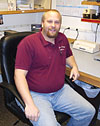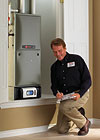
Dan Hartman, Wolff’s Plumbing and Heating, is a self-described technology junkie and loves to install heating and cooling systems with smart controls.
That paradigm is slowly changing as equipment manufacturers continue to introduce smarter, more sophisticated controls that automatically modulate the speed of the compressor and motors to meet heating and cooling needs, as well as self-diagnose problems and provide alerts for maintenance issues. Homeowners are embracing the new technology, relishing the hands-off approach to better comfort and the lower energy bills that result from these highly-efficient systems.
Contractors also appreciate the intelligent technology, citing greater levels of customer satisfaction - and fewer callbacks - as well as less time spent in the field installing and servicing these smart systems.
TURNED ON BY TECHNOLOGY
Dan Hartman, manager - residential construction and service, Wolff’s Plumbing and Heating, Spearfish, S.D., is a self-described technology junkie, which is why he is very excited about offering heating and cooling systems with smart controls. “I love HVAC technology, and if there’s something new and awesome, I’m going to roll with it,” he said.For the last year, Hartman has been actively promoting Westinghouse furnaces and heat pumps that feature the iQ Drive. With this technology, the iQ Drive controller “talks” to the outdoor unit, assessing the cooling or cooling load of the space and using the information to compute and communicate the ideal speeds to the inverter and indoor fan. The inverter and controller also get continuous feedback from the compressor. This communication occurs multiple times every second for nearly constant interaction.
If paired with an air handler, the controller calibrates the indoor blower on a periodic basis, performing a load calculation on the duct system and measuring resistance to airflow in order to learn the duct characteristics of the home and perform at optimum efficiency. When matched with a high-efficiency furnace, the controller communicates with the blower and the furnace controls to achieve the same flexible result.
Hartman likens the iQ Drive technology to operating a car. “If you want to go 20 mph, you only press down on the accelerator a little bit. If you want to go 100 mph, you press the accelerator to the floor. That’s how this system works. If you have a 100,000 Btu furnace and only 30,000 Btu is needed to heat the house, this controller is going to sense that and only provide that amount of heat.”
In addition to accurately maintaining the temperature, Hartman likes the humidity control that is part of the iQ Drive technology. “The iQ Drive can control humidifiers, and the cooling systems also dehumidify. The controller automatically changes the fan speed and volume that the compressor is running at to pull humidity out of the air. It’s a nice feature because it’s possible to dehumidify without bringing the temperature way down in the space.”
If something ever goes wrong with the system, the controller records that information, letting the technician know what needs to be fixed. If a major fault occurs, the controller touchscreen turns red and notifies the homeowner to contact the contractor immediately - with the contractor’s name and number conveniently programmed into the system.
“Troubleshooting is pretty simple,” said Hartman. “There are sensors on just about everything, and the controller logs all that information. We can walk up to the control, go into a status menu, and it tells us all the information. On the a/c and heat pump side we can see what the refrigerant cycle is doing, and on the air handler and the furnace, we can see how the blower is performing.”
As for setting up a system, Hartman said the intelligent control system makes this a breeze, saving time in the field and ensuring more accurate installations. “It’s a simple system with drop-down menus. All we do is enter in the model number of the equipment being installed, and the controller takes it from there. It walks us through the parameters of the system, and we’re done. This saves so much time over regular installations.”

Ease of installation is what Chris Zimmer, Zimmer Heating and AC, likes about selling systems with intelligent controls.
SIMPLE SET UP
The ease of installation is also what Chris Zimmer, president, Zimmer Heating and AC, Cincinnati, likes about selling systems with intelligent controls. “It’s basically a plug-and-play control. It’s easy to set up per the needs of the customer, and it’s easy to make adjustments.”Zimmer offers Carrier’s Infinity line of heating and cooling products, which feature longer heating and cooling cycles at lower fan speeds for energy savings and more consistent temperatures throughout the home. The Infinity Control is the “brains” of the system, integrating and managing temperature, humidity, airflow, ventilation, IAQ, and zoning. The control also monitors outdoor temperature and adjusts fan speed in order to provide the most comfortable indoor environment possible.
The control offers enhanced communication capabilities, such as advising when it’s time for regular maintenance and filter changes - or when humidifier pads or UV lights need servicing. When maintenance issues arise, the control provides an alert and displays the phone number of the contractor. An optional remote access kit allows the system to contact the dealer when service is required, permit remote troubleshooting, and give homeowners remote control of the system via the Internet or a telephone.
“Our customers like these systems for their performance and their comfort,” said Zimmer. “Once I explain to them how the smart system provides ultimate control of the heating and cooling equipment resulting in the best possible comfort, the homeowners are usually pretty interested.”

The ComfortLink II communicating system constantly monitors itself by performing a continuous informational loop of system diagnostics. (Courtesy of Trane.)
PEACE OF MIND
Trane dealers like the ComfortLink II Communicating System because it constantly monitors itself by performing a continuous informational loop of system diagnostics, which instantly identifies any problems and reports them, said Darren Harden, field service representative, Atlanta District Sales Office, Trane.“Dealers like the advanced diagnostics because if something happens in the system, a critical alert shows up on the Comfort Control so homeowners can notify the dealer. The fault codes help technicians quickly target the problem and fix it, so they can move on to the next service call. The more service calls that can be run in a day, it means more money that’s going to be made for the dealer.”
The ComfortLink II technology is offered on several high-end Trane products, including the XL20i air conditioning and heat pump systems and the XC-95m modulating gas furnace. With this communicating system, all the components in the cooling and heating systems communicate with each other to ensure the system is properly charged, configured, and calibrated. This constant communication results in peace of mind for homeowners, said Harden, because they can be assured their system will be installed and configured properly to deliver optimum performance and efficiency.
There is also peace of mind for the dealers, added Harden, because the systems are so easy to install. “In a retrofit situation, there’s no need to run additional thermostat wire because most homes already have three wires going to the thermostat and at least two wires going to the outdoor unit. That’s all that’s needed to install a ComfortLink II system - no additional wires are needed. Once the system is installed and turned on, it configures itself so dealers don’t have to sit there reading installers’ guides in order to set dipswitches for airflow, etc.”
In addition to configuring itself, the system virtually charges itself as well, said Harden. “With Trane Charge Assist, dealers can literally attach a drum of refrigerant to the outdoor unit, press a single button, and the unit will charge itself. It’s very accurate.”
Intelligent systems are changing the way homeowners interact with their HVAC systems, helping them to be more in control of their space conditions. Contractors benefit as well, as smart systems can reduce the amount of time in the field needed for service and installation. Sounds like a win-win situation for everyone involved.
Publication date:12/14/2009


Report Abusive Comment